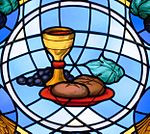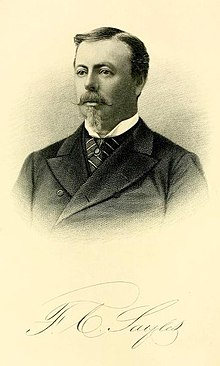기념주의
Memorialism| 다음 시리즈의 일부 |
| 성찬 |
|---|
 |
| 요소들 |
| 의식과 재판 |
| 관행 및 관습 |
| 역사 |
| 신학 |
| 분모적 가르침 |
| 관련기사 |
기념주의는 일부 기독교 교파들이 성찬에 나오는 빵과 포도주(또는 주스)의 원소(추모자에 의해 더 흔히 "주님의 만찬"으로 일컬어짐)는 순수하게 상징적으로 예수 그리스도의 몸과 피를 표현한 것으로, 잔치는 오직 기념식으로서만 성립되거나 주로 기념식으로서 성립되고 있는 것이다. 이 용어는 루크 22장 19절의 복음서 '나를 기념하여 이렇게 하라'에서 유래한 것으로, 주님의 만찬의 주요 목적은 참가자가 예수와 십자가에서 희생된 예수를 기억하도록 돕는 데 있다는 동행적 해석이다.
이 관점 일반적으로 장군 Baptists,[1][2]Anabaptists,[3]왕정 복고 Movement[3](여호와의 증인과 같은)[4][5][6]의 플리머스 Brethren,[3]구간과 일부 Non-denominational Churches,[7] 사람들뿐만 아니라 진보적 기독교를 식별에 의해 기독교의 다른 곳에서 거부됩니다, 로마 Ca등 열린다tholic 교회, 동방정교회, 오리엔탈 정교회, 교회는 동방, 감리 교회, 루터 교회 건축, 독립 가톨릭 교회 건축, 그리고 개혁 교회 건축(대륙 개혁, 성공회, 장로교, 그리고 Congregationalist 전통을 포함해)[8][9][10]들은 모두 여러가지로 진짜 presenc의 원칙을 확인합니다.e.[11][12]
즈윙리의 기념비
스위스의 개신교 개혁가인 훌리치 즈윙글리의 신학은 일반적으로 기념주의와 연관되어 있다.[13]: 56 전 로마 가톨릭 사제였던 즈윙리는 그리스도가 성찬의 신자나 하나님의 힘으로 최후의 만찬의 사건을 강렬하게 기억하는 기독교 신도들 가운데 진실로 (자연스럽지는 않지만) 존재한다고 단언했다.[14] 그러나 존 칼빈이 가르친 것처럼 성찬은 Zwingli를 위한 것으로 그리스도와 교감하는데 도구적으로 사용되지 않는다.[13]: 74
즈윙글리는 성체 성체라는 것이 요소에서 그리스도의 존재보다는 사람들의 마음 속에 그리스도가 존재하는 것에 더 가깝다고 주장했다.[15] 이는 비록 그 소송이 기독교인으로서의 중요한 면으로 남아있지만, 그것의 잠재적인 이익은 그 의식에서 사용되는 빵과 포도주와 관련된 어떠한 형이상학적 해석에서도 발견되지 않는다는 것을 나타낸다.[15]
덧붙여 즈윙글리는 루터교 신학과 달리 성서와 크레이들이 그리스도가 하늘에 계신 하나님 아버지의 오른쪽에 앉는다는 사상을 지지한다고 주장했다.[16]
역사
라트람누스는 9세기 초의 신학자로 성찬에는 성찬에 그리스도의 실제 존재가 존재하지 않는다고만 주장했다.[17]
많은 교회 아버지들이 실제 존재를 암시하고 있지만, 알렉산드리아와 테르툴리안의 클레멘트는 "기호"라는 단어를 사용하여 성체를 정의했다: "성경에서는 포도주를 성혈(알렉산드리아의 클린트)"을 신비한 상징으로 규정했고, 요한복음 6장 53-56절을 신앙에 대한 우의 대상으로 해석했다.[18] 그러나 클레멘트가 성찬식에 대한 상징적인 견해를 가지고 있다면 그것은 논쟁의 여지가 있다.[19]
참조
- ^ "Basic Beliefs: Baptism & the Lord's Supper". Southern Baptist Convention. 2018. Retrieved 5 January 2019.
The Lord's Supper is a symbolic act of obedience whereby members [...] memorialize the death of the Redeemer and anticipate His Second Coming.
- ^ "What We Believe: Baptism & the Lord's Supper". National Baptist Convention. 2018. Retrieved 5 January 2019.
We believe the Scriptures teach that Christian baptism is the immersion in water of a believer, into the name of the Father, and Son, and Holy Ghost; to show forth in a solemn and beautiful emblem, our faith in the crucified, buried, and risen Savior, with its effect, in our death to sin and resurrection to a new life; that it is prerequisite [...] to the Lord's Supper, in which the members of the church, by the sacred use of bread and wine, are to commemorate together the dying love of Christ; preceded always by solemn self-examination.
- ^ a b c Balmer, Randall Herbert; Winner, Lauren F. (2002). Protestantism in America. New York: Columbia University Press. p. 26. ISBN 9780231111300.
- ^ "The Lord's Evening Meal: An Observance That Honors God". What Does The Bible Really Teach?. Watch Tower Bible and Tract Society of Pennsylvania. 2014 [2005]. pp. 206–208. Retrieved 18 July 2020.
- ^ "The Lord's Supper: Why Do Jehovah's Witnesses Observe the Lord's Supper Differently From the Way Other Religions Do?". Watchtower Online Library. Watch Tower Bible and Tract Society of Pennsylvania. 2018. Retrieved 18 July 2020.
- ^ "The Eucharist: The Facts Behind the Ritual". The Watchtower. Watch Tower Bible and Tract Society of Pennsylvania. 1 April 2008. pp. 26–29. Retrieved 18 July 2020 – via Watchtower Online Library.
- ^ "University of Virginia Library". Religiousmovements.lib.virginia.edu. 2006-09-07. Archived from the original on 2007-10-30. Retrieved 2010-07-29.
- ^ McKim, Donald K. (1998). Major Themes in the Reformed Tradition. Wipf and Stock Publishers. ISBN 978-1-57910-104-6.
The Westminster Confession emphatically declares that Christ is truly present in the elements and is truly received by those partaking, "yet not carnally and corporally, but spiritually" (chap. 31, par. 7). The insistence is that while Christ's presence is not physical in nature it is no less a real and vital presence, as if it were a physical presence. ... Those of us in the Reformed tradition are under strong obligation to honour the notion of the real presence of Christ in the Lord's Supper.
- ^ Garvie, Alfred Ernest (1920). The Holy Catholic Church from the Congregational Point of View, namely, the One Church in the Many Churches. London: Faith Press.
He is really present at the Lord's Supper without any such limitation to the element unless we are prepared to maintain that the material is more real than the spiritual. It is the whole Christ who presents Himself to faith, so that the believer has communion with Him.
- ^ Rogers, Jack (1985). Presbyterian Creeds: A Guide to the Book of Confessions. Westminster John Knox Press. p. 115. ISBN 978-0-664-25496-4.
As whole persons we encounter the real, spiritual presence of Christ.
- ^ Neal, Gregory S. (19 December 2014). Sacramental Theology and the Christian Life. WestBow Press. p. 111. ISBN 9781490860077.
For Anglicans and Methodists the reality of the presence of Jesus as received through the sacramental elements is not in question. Real presence is simply accepted as being true, its mysterious nature being affirmed and even lauded in official statements like This Holy Mystery: A United Methodist Understanding of Holy Communion.
- ^ Losch, Richard R. (1 May 2002). A Guide to World Religions and Christian Traditions. Wm. B. Eerdmans Publishing. p. 90. ISBN 9780802805218.
In the Roman Catholic Church the official explanation of how Christ is present is called transubstantiation. This is simply an explanation of how, not a statement that, he is present. Anglicans and Orthodox do not attempt to define how, but simply accept the mystery of his presence.
- ^ a b Riggs, John (2015). The Lord's Supper in the Reformed Tradition. Louisville, KY: Westminster John Knox. ISBN 978-0-664-26019-4.
- ^ Price, Charles; Weil, Louis (2000). Liturgy for Living. Harrisburg, PA: Morehouse Publishing. p. 152. ISBN 0819218626.
- ^ a b Arcadi, James M. (2018). An Incarnational Model of the Eucharist. Cambridge: Cambridge University Press. p. 22. ISBN 9781108425896.
- ^ Stookey, Laurence Hull (2010). Eucharist: Christ's Feast with the Church. Nashville, TN: Abingdon Press. p. 54. ISBN 978-0687120178.
- ^ "Ratramnus Benedictine theologian Britannica". www.britannica.com. Retrieved 2021-12-13.
- ^ Willis, Wendell (2017-01-06). Eucharist and Ecclesiology: Essays in Honor of Dr. Everett Ferguson. Wipf and Stock Publishers. ISBN 978-1-4982-8292-5.
- ^ "Did Clement Believe in the Real Presence?". Catholic Answers. Retrieved 2021-12-13.



